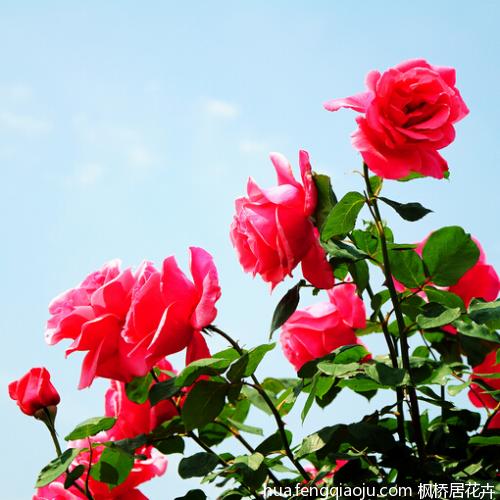How to improve the survival rate of flower bud grafting of rose
The propagation of rose by bud grafting has the advantages of high survival rate, rapid seedling formation and high propagation coefficient. In order to improve the survival rate of bud grafting of rose, we should pay attention to the following aspects.
Treatment of scion and rootstock:
The main results are as follows: (1) when selecting scion, we should not only pay attention to the variety you like, but also consider the quality of bud, the position of bud and the time of cutting. Generally, after cutting off the residual flowers, after 3-5 days, when the branches are full, the buds are full and bright, but the bud scales have not yet cracked, the strong buds in the middle of the flower branches are cut.
(2) Bud strips had better be picked up at the same time. If you can't pick it up immediately, you can wrap it with a wet cloth and store it for 2 days. if you peel the buds, you can soak the buds in water for about a day before grafting, which is easier to peel off. After picking, all leaves and stipules should be cut off at any time to reduce water transpiration, but in order to facilitate hand-held operation, it is necessary to leave a petiole of about 1 cm.
(3) to choose the plant with good affinity with rose as rootstock, the rootstock should have the advantages of exuberant growth and strong resistance. At present, wild roses are generally used as rootstocks, and rose flowers with poor varieties but good growth are also used as rootstocks. Rootstock plants used for budding must grow well, have full tissue, and be free from diseases, insect pests and mechanical damage. If the stripping method is used, the skin of the rootstock is required to be green and easy to peel off.
(4) in order to make the rootstock in the best condition during grafting, fertilizer and water management is very important. Thick fertilizer is usually applied about 10 days before grafting, and the unfilled top tips and unnecessary side branches of the rootstock are cut off. Before grafting, the water supply must be adequate, especially if the stripping method is used, the rootstock must be fully irrigated the day before, so that it can absorb enough water, make it easy to peel and supply water to the buds in time.
The influence of environmental conditions and the technical key points of budding operation:
(1) as the scion (bud piece or bud skin) used for bud grafting contains very limited water and nutrients, if it cannot heal quickly after grafting, the bud ear will wither due to loss of water. Therefore, bud grafting must be carried out in the season with the most vigorous plant growth and the most abundant nutrients in the plant, and the optimum growth temperature of rose and rose is about 20 ℃, so the bud grafting of rose in Shanghai should be carried out in May, June, September and October. It is not suitable for budding in rainy and windy weather. In the same day, we should try to choose the morning or evening with lower temperature and higher relative humidity.
(2) the knife used for bud grafting should be sterilized, and the method of peeling the bud and cutting the interface on the rootstock varies from person to person, which can be shield-shaped or rectangular; it can be peeled or wooden. No matter what form is adopted, attention must be paid to the coherence and rapidity of the whole process of incision, sprout peeling, budding and binding, otherwise it will affect the healing and survival due to excessive water loss and necrosis of surface cells.
(3) when sticking buds, note that at least one side of the bud and cambium coincides with the cambium of the rootstock. Cambium is the most exuberant place of somatic cell division in plants, and the bonding of cambium has a direct effect on the survival rate of bud grafting.
(4) the tightness of the binding should be controlled. If you tie it too tightly, it will crush the cells, damage group-weave; if you tie too loosely, it is easy to have poor contact. Therefore, the requirements are tight without injury, loose and close.
(5) after receiving, it is best to make a protective cap with an opening downward above the interface to protect against the sun and wind and rain, and to create a suitable local environment for wound healing.
(6) the ear buds are usually grafted on the base of the rootstock near the ground, so that the interface is not obvious after seedling formation, the branching point is low and the tree shape is better. However, if it is a very valuable variety, or when the quality of the bud is not very ideal, in order to be more sure, we can also use the high bud grafting method to graft the ear bud on the higher part of the rootstock above the ground or on the highest point of the long and curved rootstock branch. In this way, due to the role of top advantage, its survival rate is high and germination is fast. But do not put the ear buds on the shoots that are not yet full because of the height.
Maintenance management after grafting:
(1) do not shade after budding, and potted plants do not have to be moved indoors. It is necessary to ensure sufficient light to meet the needs of wound healing and scion germination.
(2) it is necessary to loosen the soil and provide adequate water supply to promote plant growth. Water should not be splashed on the wound when watering, because the water entering the gap to form a water film is not conducive to wound healing.
(3) it is not suitable to apply fertilizer within one week after that. Because after the rootstock absorbs fertilizer, it will cause ear bud dehydration and wilt due to the increase of osmotic pressure in the body.
(4) pay attention to observation and peel off the axillary buds and root tillers from the rootstock at any time to concentrate nutrients. However, all the branches of rootstocks above the interface should not be cut off prematurely, because these branches are rich in nutrients, which are beneficial to wound healing and ear bud germination.
(5) the wound has healed about 10 days after grafting, and the scion begins to germinate and grow. Dilute fertilizer can be applied step by step, protective cap removed and binding removed. Fertilizer and water management can be carried out according to the routine in about 20 days. When the new branches are basically formed and the branches and leaves are luxuriant, about 2 cm can be left to cut off the rootstock branches above the interface. At this point, the whole budding process is completed.
What is the breeding method of rose and how to reproduce rose?

- Prev

Maintenance tips of hanging orchids
Literally, the name "hanging orchid" is, of course, an "orchid" that can hang a potted orchid and hang the entire flowerpot with a rope or net, or an "orchid" with hanging leaves. Yes, but orchids and orchids are two completely different kinds of flowers. Orchids belong to Orchidaceae
- Next

How to conserve Rhododendron in potted plants in North China
Rhododendron alias Yingshanhong, rhododendron, belongs to the rhododendron family, rhododendron genus, is an evergreen or semi-evergreen shrub, is one of the top ten famous flowers in China, known as "flowers in the west", deeply loved by people. In the south, most of them are cultivated in the open field, which is easy to manage, but in the north, most of them are potted, which need to be managed carefully.
Related
- Fuxing push coffee new agricultural production and marketing class: lack of small-scale processing plants
- Jujube rice field leisure farm deep ploughing Yilan for five years to create a space for organic food and play
- Nongyu Farm-A trial of organic papaya for brave women with advanced technology
- Four points for attention in the prevention and control of diseases and insect pests of edible fungi
- How to add nutrient solution to Edible Fungi
- Is there any good way to control edible fungus mites?
- Open Inoculation Technology of Edible Fungi
- Is there any clever way to use fertilizer for edible fungus in winter?
- What agents are used to kill the pathogens of edible fungi in the mushroom shed?
- Rapid drying of Edible Fungi

